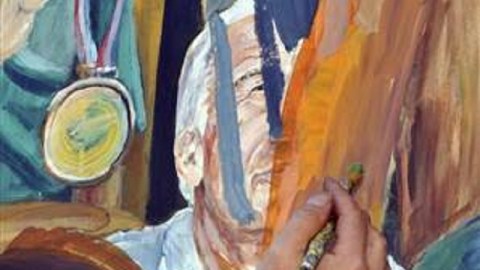The Devil in the Mural: Jerry Sandunsky, Penn State, and Giotto

Of all the surreal moments in the Penn State sex scandal surrounding the actions of former assistant football coach Jerry Sandusky, the most surreal for me was watching on a live newscast an artist painting over Sandusky’s image on a mural honoring members of the Penn State community (shown above, in mid-cover-up). The paint was barely dry before the university trustees fired iconic head football coach Joe Paterno for his actions (or inaction) related to the scandal. As I watched Sandusky’s smiling face slip into obscurity, I recalled the recent discovery of a devil’s face hidden in a 13th century mural by Giotto. Here was a strange crossroads of sorts—one devil being hidden, another being rediscovered. It’s not art imitating life, but, instead, life and art telling us something about each other.
The mural, titled Inspiration, occupies nearly half a block of the exterior of the Penn State student bookstore. With a speed I wish the university’s authorities had demonstrated years ago, artist Michael Pilato erased Sandunsky’s face from the pantheon of figures lionized for their Penn State connection and replaced him with an empty chair on which a blue ribbon sits to symbolize Sandunsky’s victims. The visual gap created by the alteration could also symbolize the gaping holes in the souls of those young boys whose innocence has been forever erased.
Thousands of miles away from “Happy Valley,” Pennsylvania, in the Basilica of St Francis in Assisi, Italy, Italian art historian Chiara Frugone found a different devil lurking in plain sight. During the restoration of fresco number 20 in the cycle of 28 scenes from the life and death of St. Francis painted by Giotto in the 13th century, Frugone found the hook-nosed face of a devil, complete with dark horns. This overlooked devil in the fine details of the mural cannot be seen from the ground, which explains how it evaded detection for eight centuries. (You can find close-up images of Giotto’s secret Satan here.)
Giotto placed his hidden devil directly beneath St. Francis as he ascends to his rightful place in heaven on clouds of glory. Giotto’s devilish humor may have driven him to insert this satanic touch as an “inside joke” the masses walking beneath would never notice. The Penn State story is no joke, of course, but Sandunsky, the devil in the mural of that campus’ life, now takes on a new significance perhaps similar to Giotto’s demon. By placing the devil directly beneath the shining image of St. Francis’ goodness, does Giotto imply that evil can exist in the most unlikely places? Rather than a silver lining, does every heavenly cloud harbor a dark, demonic interior?
As Joe Paterno seeks to resurrect his dying reputation as the last honest man of collegiate sports in America, is that painted over image of Sandunsky—now hidden, but never to be forgotten, remembered perhaps even better for its erasure—the dark interior to a shining exterior? For now, Paterno’s own face remains on the mural—a St. Francis for football fans and the Penn State students who erupted into riots last night after the announcements of Paterno’s dismissal. Will Pilato, the creator of the Penn State mural Inspiration, take inspiration from the past and ask himself, “What would Giotto do?”




